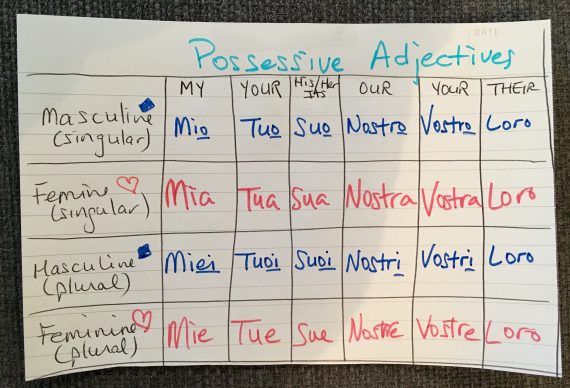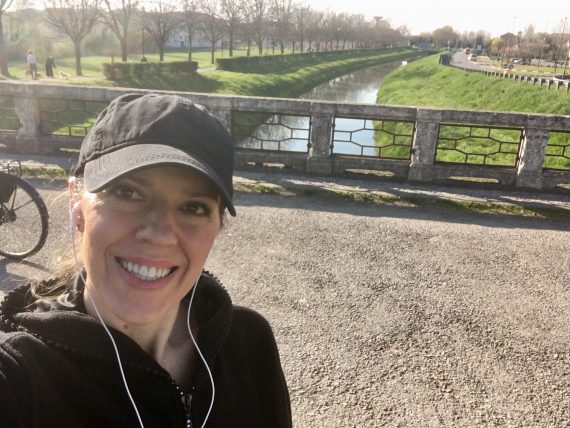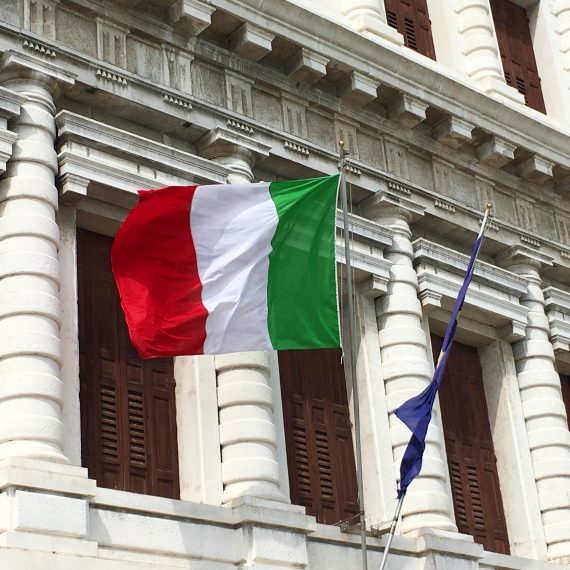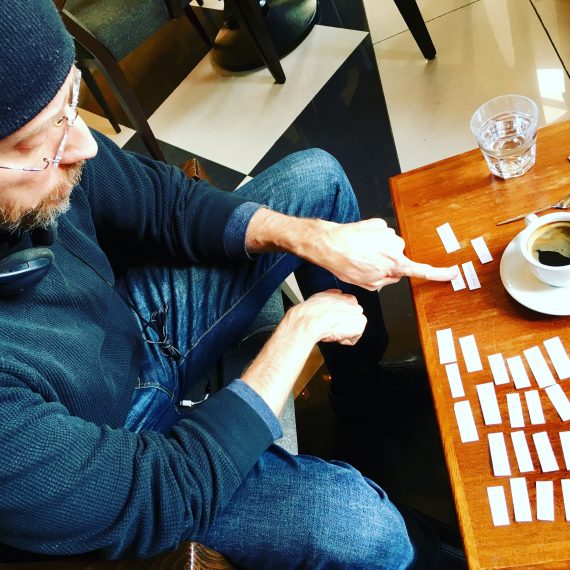
I want to learn Italian (and Spanish in the future). It’s a priority for us.
One of our main goals with world travel is to become bilingual (or tri!). Um… it’ll make me a bad-ass. #spyshit. And, it’ll increase my brain’s longevity because learning another language is serious anti-aging stuff.
In our attempts to learn Italian we began with Duolingo, flashcards, and YouTube. I soon created a full-on language learning system incorporating many different resources.
Maybe too many, but having variety feels appropriate.
- Duolingo app
- Anki flashcard app
- Traditional flashcards
- Italian music
- Learn Italian with Movies
- YouTube (Dolce Vita)
- Audible
- Podcasts
- Language School
I’ll briefly go through each one.
Duolingo
We like this app to learn Italian because it’s user-friendly and even Kamea (our 8 year old daughter) is using it. I admit that I find the phrases I’m learning weird at times. I mean why do I need to know “il tuo penguino?” (Your penguin?)
However, I can’t help but trust in the process as it’s backed by some trustworthy folks and the reviews are solid.
It’s not perfect though.
I learned French in school and the process of learning in school versus with an app like this is not the same. I feel using Duolingo solo would not be enough, so it’s only one tool in our kit.
Duolingo has a free app option for phones and tablets, which only allows you to make a set number of mistakes before having to wait 24 hours to try again. The premium version allows unlimited mistakes so you can work uninterrupted. However, using the web version is both free and allows unlimited mistakes.
I find myself using the web version more often because I like using my keyboard for typing my answers. It’s faster.
Conclusion: Duolingo is fun which is always a plus. It’s also super easy to get started. The lessons are short which can be good, but you have to be mindful to do enough of them each day or Italian will take forever to learn. The web version is my favorite because it’s free and I can make unlimited mistakes.
Anki Flashcards
Anki is a flashcard app, which is a great way to learn Italian. Like Duolingo, there is a free version on the computer but the app is not free. It’s quite pricey. I like the app version so I can practice the flashcards wherever I am. It uses a special spaced repetition algorithm for memorizing and it’s touted as being one of the best ways to memorize.
You can create your own flashcards or download decks that others have made.
Anki’s potential is robust, though I admit I’m not taking advantage of its true power. I simply made a few decks and also imported some to learn Italian.
To increase its value, I use it to make decks for Kamea with various homeschool topics like math flashcards and geography.
Conclusion: I feel like a rockstar using Anki, but I can’t really explain why. It’s super convenient using the app because I can whip it out anytime, like while waiting in line at the post office. I like making my own cards because I think that helps the learning. The only con is I miss out on the old paper-n-pen feeling.
Traditional Flashcards
I don’t know if it’s the actual writing and reading my own handwriting that helps me, but I find myself drawn to using homemade flashcards as well. As in actual paper. I know, crazy, right?
Getting nutty with colors and highlighters helps me remember things. I created a stack of verbs and expressions, which I like to flip through every few days. It’s nice to take a break from always consuming via a screen.
Good ol’ pen and paper relaxes my eyes.
Conclusion: These take time to make but using colors and different kinds of paper always helps me remember better. I can get carried away though with stickers and glitter and before you know it, I’ve spent more time creating art than learning Italian. Also, they’re not as easy to take with me when running around town, but I manage by taking a short stack of them. I did struggle finding index cards in Italy but then found a store with a paper cutter who made some for me. :)
Learn Italian with Music
One of my favorite ways to learn Italian is by listening to Italian music. I grew up listening to Bocelli and Pavarotti so those were the first albums I downloaded. Il Volo was quickly added later – so good!
Here’s a favorite song and video by those talented whippersnappers, Il Volo.
Then, I started incorporating some older Italian classics and contemporary pop and rap in Italian.
I’m the first to admit that it’s not always easy to understand what they’re singing. So, when I want to sing along I look for the lyrics online. That helps!
The first time I went back to listen to a song about 2 months into trying to learn Italian, and I was recognizing more words, was a fun day! Connections were forged. Each time I go back now, I pick up a few more words and I’m encouraged even more.
Conclusion: Listening to music is great because I can do it while getting ready, taking a shower, cleaning our home. It taps into my soul, too, as music should. Listening to Italian music feels like it connects me more to the culture. It’s also nice that it doesn’t take as much effort and I can be more passive with it. I have to be careful, though, that I don’t tune it out.
Movies

Watching Italian movies is a fun way to learn Italian, specifically movies in Italian with subtitles in English. The best way to take advantage of learning Italian with movies is by watching them over and over. I haven’t done that yet, because I keep finding new ones I want to watch. But, I should.
Watching movies is not only entertaining but you hear different phrases, and you get to see some of Italy. Being entertained while I learn Italian makes it not only fun but easier. Let’s not forget that you’ll learn some of the gestures, too. :)
Conclusion: The real trick here is the repetition which I’ve yet to do. However, by the time you’re using flash cards, listening to Italian music, and then also watching a movie each night… it’s a nice well-rounded immersion of sorts.
YouTube
YouTube is a great resource to help you learn Italian, and it’s free.
There is one course I found especially helpful called Dolce Vita. It’s about 30 videos – learn Italian in 30 days.
Now, you won’t learn it all, of course, but you’ll get some basics from a native speaker. The videos are short lessons and if you take notes and watch them a couple of times you’re well on your way.
Audible Books & Podcasts
Downloading a program to learn Italian via Audible is a great choice, too.
Each chapter of the particular book I bought focuses and builds. I like having something like this to allow me to take my efforts to learn Italian with me on walks.
The same goes for podcasts. One of my favorites is Coffee Break Italian. I also found but haven’t tried yet, Five Minute Italian.
I have to concentrate while listening to these so I can repeat them. Greg listens to them while working out at the gym, but I can’t do anything other than walking while listening for the ultimate focus.
Language School
Language school in country is a great option, because you have a native speaking teacher who, hopefully, knows how to teach learning a language. It can get costly though.
Fortunately, we have a school locally in Rovigo, Italy, where we can learn Italian cheaply because the classes are subsidized.
They are limited in when they’re offered, so until we can take those frugally priced group lessons (in the fall), we’ve decided to invest in our language learning and purchase a month of private group lessons with just the three of us.
I’m most excited about this part of our language acquisition because it’ll give us the greatest acceleration in learning – again learning from a professional.
It’s also going to be especially helpful for Kamea to be in an organized environment. It’s a great worldschooling experience.
Getting Out and Chatting with Locals
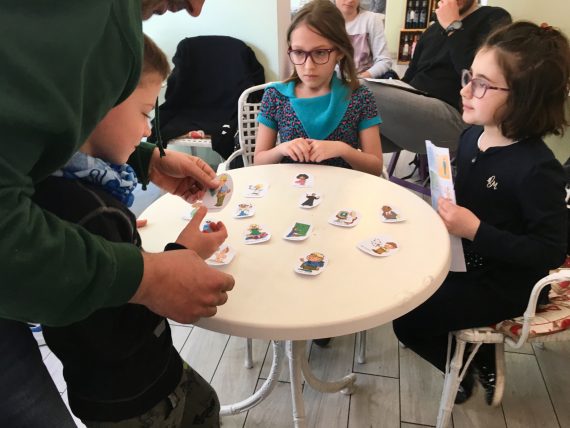
Obviously, getting out and just trying to speak the language with locals will do more for me than anything really, short of the language school.
I’m not a afraid to make mistakes and I flub all the time. The Italians are so patient while I’m trying to learn their beautiful language.
For me, creating a sentence takes time, but I can manage with basic words. My challenge is listening and comprehending. I don’t have a large enough Italian vocabulary yet.
We get together with locals at the park and in cafes which we love. It enriches the experience like none other. The more we do this, the more successful we’ll be in learning Italian.
In fact, funny story… I met a woman who runs a local salumi shop – we got to chatting – and it was hilarious to discover she used to be the nanny to the lawyer we hired to help us with dual citizenship. Small town. Anyway, she invited me to coffee and I’m excited to take her up on it. She speaks very little English and non parlo italiano ancora ma sto imparando (I don’t speak Italian yet but I’m learning).
My brain is tired from all the effort and it’s a daily challenge.
From the minute I leave my house, to the minute I come home, I’m in a constant learning and struggling mode.
It’s utterly exhausting.
But the benefits will come.
Like working out in the gym, you have to work the muscles to make them bigger and stronger. Same with my attempts to learn Italian. Like a muscle, the brain is making physical changes when you learn a new language. For an adult, rapid neural growth comes as a response to stress. In other words, no pain, no gain!
I became serious about my attempts in January, using the above mentioned methods. They help, yes, especially for at least traveling in Italy as a tourist. However, the methods are also all over the place, and it feels fragmented at times. I like the diversity of options but I yearn for a solid, structured program.
I’m confident that starting language school with private lessons will accelerate my learning rapidly, but until our classes begin, we’re doing what we can on our own.
